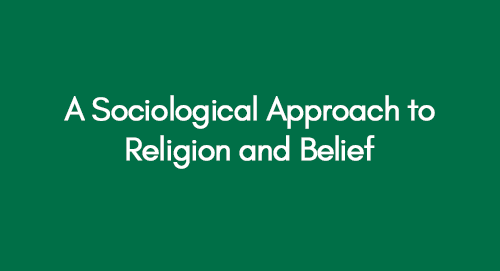
How Technology Can Be Used to Change the Face of Tertiary Education System: Integrating Mobile Learning into Tertiary Education and Barriers.
July 6, 2022
Different Approaches to Academic Research
July 9, 2022Sociological viewpoints on religion seek to explain the roles that religion performs, the differences and other issues that it may exacerbate and promote, and the part it plays in our everyday lives (Mirola and Monahan, 2016).
The objective of Professor Durkheim is to research the roots of religion. Religion has quite a true existence. It is a reality founded on sociology, and it has outlived all its opponents and all the criticisms posed against it.
Examine More About a Sociological Approach to Religion and Belief Here
In sociology, things can't last if they're based on lies and errors because life's truth is important. Religion, thus, has its origins in fact and refers to individual needs. The explanations that justify it might be somewhat different from those brought out by the believers. However, there are many explanations, so it is the domain of research to find them.
Consider the Key Characteristics of Religion and Recognize Alternative Belief Systems
The Religion definitions appear to suffer from one of two problems: either they are overly restrictive and preclude certain religious structures that often identify with religions, or they are too broad and confusing, implying that just about everything and all is a religion. The easiest approach to describe the essence of faith is to define the fundamental attributes relevant to religions. Such features can be shared with certain forms of belief, however, taken together they make faith distinct (Mirola and Monahan, 2016).
Discover the Most Noticeable Feature of Religious Beliefs Here
Believing in the divine, particularly the gods, is one of the most evident characteristics of religious belief (Frisk and Nynäs, 2012). It is so common, in reality, that some people make a mistake for faith alone; but that's incorrect. Theism may take place without Christianity, and certain religions are atheistic. In light of this, spiritual theories are a widespread and basic feature in most faiths, although the presence of supernatural entities is rarely stipulated in non-religious belief systems. The differentiation between the holy and the profane is widespread and significant enough in religions that some scholars of religion. In particular, Mircea Eliade (2012), has proposed that this differentiation should be considered a distinguishing feature of religion. Making such a difference will also guide adherents to reflect on transcendental ideals and the spiritual, yet unseen, dimensions of the universe around us. Sacred moments, locations, and artifacts inform us that there is more to life than what we see.
Identify Different Types of Religious Organisations
There are several forms of religious groups in multicultural communities. Sociologists typically divide them by scale and power. There are three forms of religious groups classified as such: church, sect, and cult (Ogien, 2016). The church also has two subtypes: ecclesia and denomination (Tinaz, 1963). The Church is a massive, bureaucratically structured faith institution that is tightly incorporated into the broader community. There are two forms of church organizations. The first is the ecclesia, a massive, hierarchical religious body that is a structured part of the state that has the majority or more of the population of the state as its representatives. The second category of church organization is the denomination, a broad, hierarchical faith body that is tightly incorporated into the broader community but is not a structured member of the state (Tinaz, 1963).
Explain the Main Features of At Least Two Theories on the Relationship between Religion and Society
Most of Émile Durkheim's research underscored the purposes that faith offers culture, irrespective of whether it is conducted or what particular religious views culture prefers (Durkheim and Swain, 1915). Today, Durkheim's ideas tend to affect sociological research on the roles of faith.
- Firstly, religion gives life purpose and meaning (Mirola and Monahan, 2016). Second, religion promotes social harmony and peace. This was one of the most significant observations of Durkheim. Religion promotes societal harmony in at least two respects.
- Second, it offers citizens a similar collection of values and is thus an essential agent of socialization (Durkheim and Swain, 1915).
- The third feature in faith is linked to the one that has already been addressed. Religion is an instrument of collective influence and thus enhances societal order. Religion teaches people spiritual actions and thereby allows them to understand how to be successful citizens of the community.
- The fourth feature of faith is improved psychological and physical well-being. Christian spirituality and activity can improve spiritual well-being by providing a source of support for citizens in times of crisis and by improving their social contact with others in houses of worship (Durkheim and Swain, 1915). The final feature of faith is that it will inspire citizens to strive toward meaningful social change.
Conflict theory
“Religion has all these benefits, though, as per conflict theory; religion might also perpetuate and promote socio-economic inequality and social unrest. This opinion is partially influenced by the work of Karl Marx, who claimed that faith was the "opiate of the people" (Marx, 1964). In that, he suggested that religion, as an element, would render people happy in their current conditions. Marx continuously asserted the need for workers to stand up and fight the bourgeois. But individuals who seem to be deeply religious, he acknowledged, chose to see their distress in religious terms. They assume it is the will of the Divine that they have been irredeemable because they test their faith in Him or they have breached His rules. Many people fear that if they accept their suffering, they will be rewarded in the future. Their moral beliefs drive them not to accuse the capitalist class of their poverty, and therefore not to revolt. For these purposes, Marx said, religion leads the oppressed to acknowledge their misery and helps to maintain the existing system of social inequality.”
Examine Research Evidence on Religion and Belief in a Contemporary Society
“Traditionally, religion has become a major influence in social change. Throughout early Europe, the incorporation of religious scriptures into common, non-scholar language enabled people to form their religions. Disagreements within religious groups and incidents of racial persecution have led to mass displacement, violence, and even genocide. To a certain degree, the existing democratic political system and international law may be viewed as a consequence of the conflict between religious principles developed in Europe by the Treaty of Westphalia (1648) which culminated in the Thirty Years' War (Onnekink, 2016).”
Identify and Explain Any Similarities and Differences between Two or More Theories and Studies
Many psychologists describe the emergence and continuity of faith in Darwinian evolutionary theory. For this claim, they include a conceptual description of the universal religious existence or the condition of being normal to all religions' varied social types and environments. Psychologist Roger Cloninger describes this central faith concept as a tendency of self-transcendence (De Raad and Mlačić, 2015). It has three observable components: self-forgetful transpersonal identity (perception of divine unity with the world and capacity to minimize self-limitation vs. others) and mysticism (perception or recognition of events that cannot be rationally explained). The argument is that, since this is a common disease, it must have a particular physiological or genetic history that is transmitted down across generations that promotes human survival.
At the same time as religion continues to have a significant impact on western civilization, it is steadily secularised in cultures. Sociologist José Casanova defined secularisation as a social and historical concept as three interlinked occurrences, both of which are open to debate: 1) deteriorating religious beliefs and practices in western cultures; 2) The privatization of religious belief; and 3) Separation of secular spheres (state, society, science) is commonly viewed as "emancipation" from religious organizations (Pollack, 2015).
Evaluate Evidence on Religion and Belief
“Although some academics see the Western world, like Canada, become more secular, some note that Christianity is still among us. For example, recent figures indicate that around 75% of Canadian weddings still include religious rituals. However, that differs from 90% in Ontario to fewer than 40% in British Columbia. Trinity Western University, a prominent private Christian college in British Columbia, is in controversy because a variety of state bar societies have decided not to accept graduates in Trinity's latest law program. One of the major issues is the "covenant" of the institution, which requires the members to consent to prevent sex until it is part of a relationship between a man and a woman. The University plans to introduce bar associations in British Columbia, Ontario, and Nova Scotia to trial to respond to difficulties with religious freedom. (CBC 2014).”
Give a Sociological Analysis of Changes in Religion and its Relationship to Contemporary Society
While it is not thoroughly researched, there are signs that the much-discussed global re-emergence of religion is tied to the increasingly global growth of deregulated capitalist markets. So far, work has mainly centered on the individualizing implications of market cultures and the consequent belief in ‘spirituality’ as opposed to the more institutionalized 'religion'. But there are many forms of looking at ties in the sense of the 21st century: on the one side, globalization and liberalism endanger culture in general and faith in particular, a challenge that generates religious resistance groups such as the Taliban and American conservative evangelicalism, to name two of the more prominent instances (Nesbitt, 2020). On the other side, growing social inequality may be seen as providing a 'market' for religions that have a 'promise of redemption'.
Outline Key Changes in Patterns of Religious Participation and Belief
The 'mediation' of culture, the mechanism by which our daily awareness is gradually filtered through means of mass communication, is a pervasive feature of contemporary societies. Although the media revolution was already apparent in 1990, unlike the face-to-face case, the answer to a newspaper article is seldom made public (Hjarvard, 2011). However, historically unseen ways of indirect social exchange have arisen in the 21st century: for example, forums and social networking overflow with commentary on news from across the globe. Over the years religion has seeped into these new mediums and has provided people with new platforms to unite together for their religious beliefs (Hjarvard, 2011).
Discuss the Social Significance of These Changes, concerning Sociological Theories
Even though some people believe that religion has some human elements (because religious views may be extremely personal), religion is often a collective structure for sociologists. Social scientists understand that faith operates as a structured and interconnected collection of views, attitudes, and expectations based on fundamental societal needs and values. Faith is a common characteristic present in all social classes. In any society, for example, funeral ceremonies are performed in some manner, but such rituals differ across societies and within religious affiliations. Durkheim projected that the power of faith would decline as culture modernized (Durkheim and Swain, 1915). He assumed that rational science would eventually overtake traditional thought, with people paying little attention to traditions and procedures. He also believed that the idea of "Jesus" was on the brink of extinction. Alternatively, he imagined a community that encourages secular worship, in which, for example, public festivals, parades, and pride take the place of religious services. Nevertheless, if mainstream Christianity were to survive, he claimed that it should do so only as a way to maintain societal stability and order. While people generally believe that Marx did not see a position for faith, this presumption is not completely accurate. Marx claimed that faith acted as a refuge from the harshness of daily existence and the injustice of the wealthy. Even, he expected that one day the mainstream faith would move away (Marx, 1964).
References
Black, Debra. 2007. “Marriages rise in Ontario, B.C. while Canadian rate plateaus”. The Star Newspaper.[online]http://www.thestar.com/news/2007/01/18/marriages_rise_in_ontario_bc_while_canadian_rate_plateaus.html
CBC News. 2014. “Trinity Western launches court action to defend law school.” BC News. May 06, 2014. Nova Scotia. [Online] (http://www.cbc.ca/news/canada/nova-scotia/trinity-western-launches-court-action-to-defend-law-school-1.2633816)
De Raad, B. and Mlačić, B., 2015. Big five factor model, theory and structure. International encyclopaedia of the social & behavioural sciences, 2.Durkheim, E. and Swain, J.W., 1915. The Elementary Forms of the Religious Life Trans from the French. George Allen and Unwin Limited.
Eliade, M., 2012. Occultism, Witchcraft, and Cultural Fashions: Essays in Comparative Religion. University of Chicago Press.
Frisk, L. and Nynäs, P., 2012. Characteristics of Contemporary Religious Change: Globalization, Neoliberalism, and Interpretative Tendencies. Post-secular society, pp.47-70.
Hjarvard, S., 2011. The mediatisation of religion: Theorising religion, media and social change. Culture and religion, 12(02), pp.119-135.
Marx, K., 1964. Karl Marx: early writings. McGraw-Hill.
Mirola, W. and Monahan, S.C., 2016. Religion matters: What sociology teaches us about religion in our World. Routledge.
Nesbitt, P.D., 2020. Engaging Religion in a Contested Age: Contestations, Postmodernity, and Social Change. Sociology of Religion.
Ogien, A., 2016. Durkheim as a sociologist of knowledge: Rudiments of a reflexive theory of the concept. Journal of Classical Sociology, 16(1), pp.7-20.
Onnekink, D. ed., 2016. War and Religion after Westphalia, 1648–1713. Routledge.
Pollack, D., 2015. Varieties of secularization theories and their indispensable core. The Germanic Review: Literature, Culture, Theory, 90(1), pp.60-79.
Tinaz, N., 1963. A Social Analysis of Religious Organisations: The Cases of Church, Sect, Denomination, Cult and New Religious Movements (NRMs) and Their Typologies. Archives de Sociologie des Religions, 16, pp.49-63.



























